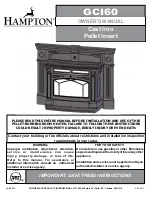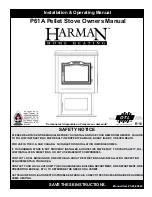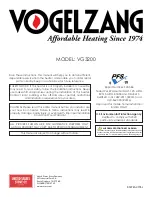
5
RACCORDO AL CAMINO
Collegare la stufa alla canna fumaria tramite
tubi in lamiera del tipo comune da fumisteria,
aventi un diametro di 120 mm.
Curare la perfetta tenuta degli innesti e delle
giunture. E' opportuno evitare i tratti orizzon-
tali; dare sempre una pendenza in salita al-
meno del 10%.
Limitare il più possibile i gomiti; attenersi in
ogni caso a quanto prescritto dalle norme
UNICIG 7129 e 7131.
La canna fumaria dovrà presentarsi in ottime
condizioni; possibilmente fornita di cappa
antivento.
ACCENSIONE BRUCIATORE
1) Prima di innestare la spina nella presa di
corrente, aprire la portina (seguendo le
istruzioni di fig. 4) e spingere verso il bas-
so la leva di sicurezza valvola (fig. 3).
2) Richiudere la portina (sempre seguendo
le istruzioni di fig. 4) ed innestare la spina
alla presa di corrente (220 volt).
3) Togliere il tappo serbatoio (fig. 2), effet-
tuare il caricamento combustibile e pro-
cedere nel modo seguente:
4) Ruotare la manopola rubinetto serbatoio
(fig. 2) nel senso della freccia rivolta ver-
so la dicitura "aperto".
5) Portare la manopola comando sulla posi-
zione Accensione ( ) e attendere alme-
no 2 minuti. La lampada spia si accende-
rà indicando che la candeletta è in funzio-
ne.
6) Portare la manopola comando (fig. 2) sul-
la posizione 1 e attendere almeno 10 mi-
nuti.
7) Acceso il bruciatore spostare gradualmen-
te ad intervalli la manopola comando (fig.
2) sino al raggiungimento della posizione
voluta.
RACCORDEMENT A LA CHEMINE
Raccorder le poêle au carneau au moyen de
tuyaux en tôle de type courant d’un diamètre de
120 mm. Veiller à ce que les embrayages et les
jointures soient parfaitement étanches. Il
convient d’éviter les tronçons horizontaux,
l’inclinaison en montée doit toujours être d’au
moins 10%.
Limiter le plus possible les coudes et s’en tenir
dans tous les cas aux prescriptions des normes
UNICIG 7129 et 7131.
Le carneau devra être en parfait état et si possible
équipé d’un dispositif anti-vent.
ALLUMAGE DU BRULEUR
1) Avant de brancher la fiche dans la prise de
courant, ouvrir le portillon (en suivant les
instructions de la fig. 4) et pousser vers le
bas le levier de sécurité de la soupape (fig.
3).
2) Refermer le portillon (toujours en se
conformant aux instructions de la fig. 4) et
brancher la fiche dans la prise de courant
(220V).
3) Oter le bouchon du réservoir (fig. 2), introduire
le combustible et procéder de la manière
suivante:
4) Tourner la poignée du robinet du réservoir
(fig. 2) dans le sens de la flèche tournée vers
l’inscription “aperto” (ouvert).
5) Placez la manette de commande sur la
position Allumage (
) et attendez 2 minutes
au moins. Le voyant s’allumera pour signaler
que la bougie est activée.
6) Placez la manette de commande (dessin 2)
sur la position 1 et attendez 10 minutes au
moins.
7) Une fois le brûleur allumé, tourner
graduellement la poignée de commande par
intervalles (fig. 2) jusqu’à atteindre la position
voulue.
CONNECTION TO THE FLUE
Connect the stove to the flue using normal 120
mm diameter steel tubes designed for this
purpose. Make sure that the joints and
connections are perfectly sealed. Do not install
pipes horizontally but sloping upwards by at
least 10%.
Use elbows as little as possible. In any case
observe the provisions of UNICIG 7129 and
7131 standards.
The flue must be in perfect condition and
preferably fitted with a wind hood.
LIGHTING THE BURNER
1) Before inserting the plug in the electrical
power socket, open the door (following the
instructions in fig. 4) and push the valve
safety lever downwards (fig. 3).
2) Close the door (again following the
instructions in fig. 4) and insert the plug in the
power socket (220 V).
3) Take off the fuel tank cap (fig. 2), fill up with
fuel, then proceed as follows:
4) Turn the fuel tank tap handle (fig. 2) in the
direction marked by the arrow with the word
"aperto" (open).
5) Turn the control knob round to the ON position
( ) and wait at least 2 minutes. The
indicator light will turn on meaning that the
igniter plug is working.
6) Turn the control knob (fig. 2) round to position
1 and wait at least 10 minutes.
7) Once the burner has lit, move the control
knob (fig. 2) gradually and at intervals until
the desired position is reached.
CONEXION A LA CHIMENEA
Conecten la estufa al conducto de humo por
medio de los tubos de chapa del tipo común
para estos conductos, con un diámetro de
120 mm. Verifiquen que las conexiones y las
juntas estén perfectamente acopladas. Es
conveniente evitar los tramos horizontales,
dejen siempre una inclinación de subida como
mínimo del 10%.
Limiten lo máximo posible los codos:
aténganse siempre a las prescripciones de
las normas UNICIG 7129 y 7131.
El conducto de humo deberá estar en óptimas
condiciones; posiblemente provisto de cam-
pana anti-viento.
ENCENDIDO DEL QUEMADOR
1) Antes de enchufar la clavija en la toma de
corriente, abran la portezuela (siguiendo
las instrucciones de la fig. 4) y empujen
hacia abajo la palanca de seguridad de la
válvula (fig.3).
2) Cierren la portezuela (siempre siguiendo
las instrucciones de la fig. 4) y enchufen la
clavija a la toma de corriente (220 Volt).
3) Quiten el tapón del depósito (fig. 2),
carguen el combustible y realicen las
siguientes operaciones:
4) Giren la manilla del grifo del depósito (fig.
2) en el sentido que indica la flecha,
colocándola hacia la palabra “aperto”
(abierto).
5) Coloquen el botón de mando en posición
de Encendido ( ) y esperen por lo menos
2 minutos. El piloto se encenderá para
indicar que la bujía está en funcionamiento.
6) Coloquen el botón de mando (fig. 2) en la
posición 1 y esperen por lo menos 10
minutos.
7) Una vez encendido el quemador desplacen
gradualmente y a intervalos el botón de
mando (fig. 2) hasta alcanzar la posición
deseada.


























